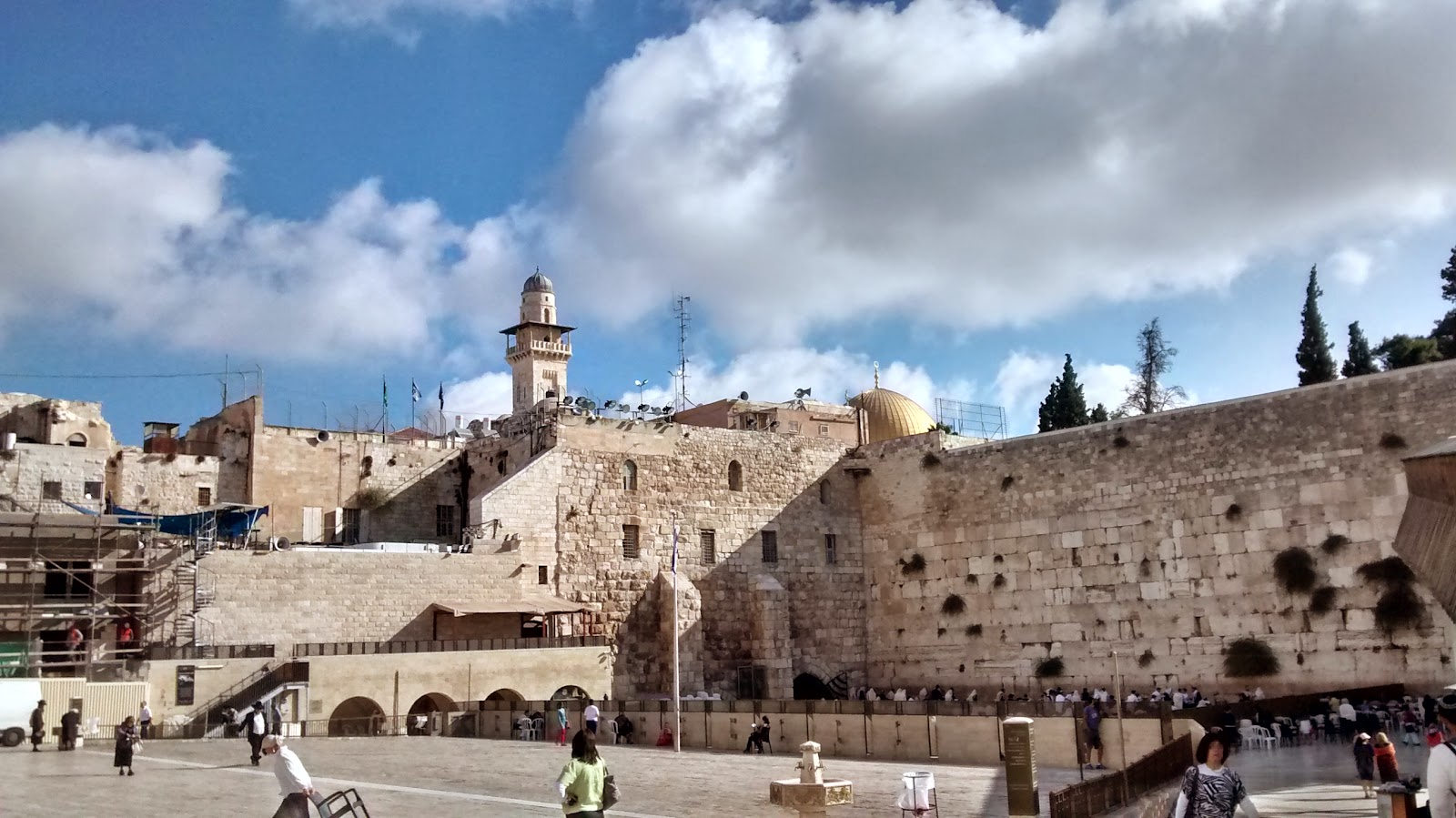 |
| Our first view of Jerusalem |
This post is long overdue. There is no excuse. Yet, even this feeble blog post will do little to encompass all the magnificence that is Jerusalem. Our tour guide planned everything, every our entrance to our first city view, having our driver play "Jerusalem, Jerusalem" as we turned and saw the Dome of the Rock glowing in the afternoon sun. We stopped on the edge of town at a university and took our first photos looking down on Jerusalem sprawling below us.
 |
| Western Wall |
Our first visit was to the
Western Wall (also known as the Wailing Wall). Our guide explained how this was the wall closest to the Holy of Holies of the last Temple. Since the temple has not been rebuilt, Jews worship at this wall for now. The wall is separated into a portion for women and a portion for men. The genders are not allowed to mingle. In addition, on the men's side, there is a side door where copies of the Torah are kept. Only men are allowed in. Women can enter at a different entrance and peer down at the Torah. In front of the wall, people are praying and reading from scriptures, both silently and in quiet whispers. Some sway back forth in their worship. Tiny pieces of paper fill every crevice between the rocks in the wall. People believe that their prayers are stronger placed here, so much so that there are even internet services to print off and insert your prayer into the wall. Our guide gave us time here to meditate and pray. It was truly an awe-inspiring, spiritual experience. Afterward, we took a tour inside the wall. It is built onto the bedrock of Mount Moriah. We walked into former rooms that were then used as cisterns. Finally, we walked along the side of the wall in an excavated tunnel, feeling just a bit like intrepid adventurers.
 |
| Model of Jerusalem at Israel Museum |
Next, our tour guide took us to the
Israel Museum. Her main goal was for us to see a visual representation of Jerusalem. On the museum patio is an intricate
model of Jerusalem from ~66 CE. From our first night meeting our guide in Netanye, she had been pointing out the "shin" symbol on the mezuzahs attached to our door frames. The mezuzah is placed on every door frame and has a prayer inside. Today, our guide showed us how the "shin" symbol is the geography of the city of Jerusalem. The left line is the Valley of Gahenna; the center line is Tirapol; and, the right line is the Valley of Kidron. (Here's one artist's
visualization.) She pointed out major landmarks in Jerusalem as well as showing us where Jesus would have walked from his entry on Palm Sunday until his crucifixion on Good Friday. This is when we learned that the traditional sites in Jerusalem for the twelve stations of the cross are not necessarily the historical sites. In the Jerusalem Museum, there is an onion domed building that houses both the
Dead Sea Scrolls as well as the
Aleppo Codex. The Isaiah scroll was displayed as the centerpiece of the circular wing. Unfortunately, we did not have time to visit any other wings in the Israel Museum.
Our final and most chilling stop of the day was the
Holocaust Museum. It is a very intense and extensive coverage of everything Holocaust related, from detailed historical information to a room with all the names of the Jewish victims of the Holocaust.
 |
| Old city walls and sealed East Gate |
The next day, we started bright and early on our way up to the Mount of Olives, which is currently a Jewish cemetery. Looking across from the Mount of Olives, one can see the sealed East Gate of the walls of Old Jerusalem. These walls were built by Suleyman the Magnificent in the 1500s to protect against the Crusades of Spanish emperor Charles. There's a legend that upon completion of the walls, Suleiman executed the architects since they forgot to include Mount Zion and the tomb of King David within the city walls.
 |
| Garden of Gethsemane |
Next, we walked down into the
Garden of Gethsemane. Within the garden, gnarled, old olive trees still live. They are fenced off to avoid visitors getting too close to these 2000+ year old trees. But, one can still walk through the garden and enjoy their beauty. On the site, there is a beautiful Church of All Nations with stunning mosaics.
 |
| Inside the basement of Caiaphus's house |
Our next stop was
Caiaphus's house. On this spot is now a nunnery called
Saint Peter of Gallicantu. When we visited, we were the only visitors. Our guide took us down into the place where Jesus was supposedly held. In the basement of the house, we could see steps of what looked like a ritual baths as well as depressions in the floor for holding jars.












